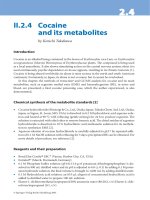What makes a great training organization a handbook of best practices
Bạn đang xem bản rút gọn của tài liệu. Xem và tải ngay bản đầy đủ của tài liệu tại đây (776.39 KB, 193 trang )
What Makes a Great
Training Organization?
A Handbook of Best Practices
Doug Harward
Ken Taylor
Vice President, Publisher: Tim Moore
Associate Publisher and Director of Marketing: Amy Neidlinger
Development Editor: Russ Hall
Operations Specialist: Jodi Kemper
Cover Designer: Chuti Prasertsith
Managing Editor: Kristy Hart
Project Editor: Andy Beaster
Copy Editor: Kitty Wilson
Proofreader: Katie Matejka
Indexer: Tim Wright
Compositor: Nonie Ratcliff
Manufacturing Buyer: Dan Uhrig
© 2014 by Pearson Education, Inc.
Published by Pearson Education, Inc.
Upper Saddle River, New Jersey 07458
Pearson offers excellent discounts on this book when ordered in quantity for bulk purchases or special sales. For more information, please contact U.S. Corporate and Government Sales, 1-800-382-3419, For sales outside the
U.S., please contact International Sales at
Company and product names mentioned herein are the trademarks or registered trademarks of their respective owners.
All rights reserved. No part of this book may be reproduced, in any form or by any
means, without permission in writing from the publisher.
Printed in the United States of America
First Printing March 2014
ISBN-10: 0-13-349196-X
ISBN-13: 978-0-13-349196-8
Pearson Education LTD.
Pearson Education Australia PTY, Limited
Pearson Education Singapore, Pte. Ltd.
Pearson Education Asia, Ltd.
Pearson Education Canada, Ltd.
Pearson Educación de Mexico, S.A. de C.V.
Pearson Education—Japan
Pearson Education Malaysia, Pte. Ltd.
Library of Congress Control Number: 2013957861
This book is dedicated to all of those training professionals who work tirelessly to make sure they provide
the type of training and development programs that
truly impact the lives of the learners, while ultimately
transforming the performance of their business.
Contents
Introduction: Why We Wrote This Book . . . . . . . . . . . . .1
The Demographics of the Research Pool . . . . . . . . . . . . . . 2
Chapter 1
The Eight Process Capability Areas
of a Training Organization. . . . . . . . . . . . . . . . . . . . . . . . .7
The Eight Key Process Capabilities . . . . . . . . . . . . . . . . . . . 8
Organization Ratings. . . . . . . . . . . . . . . . . . . . . . . . . . . . . . 10
Conclusion. . . . . . . . . . . . . . . . . . . . . . . . . . . . . . . . . . . . . . 14
Chapter 2
The Importance of Learning Leadership . . . . . . . . . . . .15
Conclusion. . . . . . . . . . . . . . . . . . . . . . . . . . . . . . . . . . . . . . 18
Chapter 3
Strategic Alignment . . . . . . . . . . . . . . . . . . . . . . . . . . . . .19
Strategic Alignment Practices . . . . . . . . . . . . . . . . . . . . . . 24
Conclusion. . . . . . . . . . . . . . . . . . . . . . . . . . . . . . . . . . . . . . 32
Chapter 4
Diagnostics . . . . . . . . . . . . . . . . . . . . . . . . . . . . . . . . . . . .33
Differences Between Diagnostics and
Strategic Alignment . . . . . . . . . . . . . . . . . . . . . . . . . . . . . 34
Linking Diagnostics and Content Development . . . . . . . . 38
Case Study for Diagnostics: Performance
Architecture . . . . . . . . . . . . . . . . . . . . . . . . . . . . . . . . . . . 39
The Most Critical Diagnostic Practices . . . . . . . . . . . . . . . 41
Conclusion. . . . . . . . . . . . . . . . . . . . . . . . . . . . . . . . . . . . . . 50
Notes . . . . . . . . . . . . . . . . . . . . . . . . . . . . . . . . . . . . . . . . . . 50
Chapter 5
Content Development . . . . . . . . . . . . . . . . . . . . . . . . . . .53
The Most Critical Content Development Practices . . . . . 54
Conclusion. . . . . . . . . . . . . . . . . . . . . . . . . . . . . . . . . . . . . . 71
Note. . . . . . . . . . . . . . . . . . . . . . . . . . . . . . . . . . . . . . . . . . . 72
Chapter 6
Content Delivery . . . . . . . . . . . . . . . . . . . . . . . . . . . . . . .73
Delivery Modalities. . . . . . . . . . . . . . . . . . . . . . . . . . . . . . . 73
Instructor Quality . . . . . . . . . . . . . . . . . . . . . . . . . . . . . . . . 76
The Most Critical Delivery Practices. . . . . . . . . . . . . . . . . 76
Conclusion. . . . . . . . . . . . . . . . . . . . . . . . . . . . . . . . . . . . . . 83
CONTENTS
Chapter 7
Administrative Services . . . . . . . . . . . . . . . . . . . . . . . . . .85
The Most Critical Administrative
Services Practices . . . . . . . . . . . . . . . . . . . . . . . . . . . . . . . 87
Conclusion. . . . . . . . . . . . . . . . . . . . . . . . . . . . . . . . . . . . . . 92
Chapter 8
Measurement and Certification . . . . . . . . . . . . . . . . . . .95
Measurement as a Strategy. . . . . . . . . . . . . . . . . . . . . . . . . 97
Conclusion. . . . . . . . . . . . . . . . . . . . . . . . . . . . . . . . . . . . . 104
Notes . . . . . . . . . . . . . . . . . . . . . . . . . . . . . . . . . . . . . . . . . 104
Chapter 9
Reporting and Analysis . . . . . . . . . . . . . . . . . . . . . . . . .105
The Most Critical Reporting and Analysis Practices . . . . 108
Conclusion. . . . . . . . . . . . . . . . . . . . . . . . . . . . . . . . . . . . . 114
Notes . . . . . . . . . . . . . . . . . . . . . . . . . . . . . . . . . . . . . . . . . 115
Chapter 10
Portfolio Management . . . . . . . . . . . . . . . . . . . . . . . . . .117
Getting the Portfolio Mix Right . . . . . . . . . . . . . . . . . . . . 119
The Most Critical Portfolio Management Practices . . . . 122
Conclusion. . . . . . . . . . . . . . . . . . . . . . . . . . . . . . . . . . . . . 128
Notes . . . . . . . . . . . . . . . . . . . . . . . . . . . . . . . . . . . . . . . . . 129
Chapter 11
The Role of Technology in Learning . . . . . . . . . . . . . .131
Technologies Should Enable the Learning
Experience and Never Be a Distraction . . . . . . . . . . . . 135
Match Tools to Learning Styles . . . . . . . . . . . . . . . . . . . . 136
Technologies Can Reduce the Barriers
of Geography and Time . . . . . . . . . . . . . . . . . . . . . . . . . 136
Technology Standards Allow for Improved
Interoperability and Access of Content. . . . . . . . . . . . . 137
Conclusion. . . . . . . . . . . . . . . . . . . . . . . . . . . . . . . . . . . . . 138
Notes . . . . . . . . . . . . . . . . . . . . . . . . . . . . . . . . . . . . . . . . . 139
Chapter 12
Technology Integration . . . . . . . . . . . . . . . . . . . . . . . . .141
Technology Platforms . . . . . . . . . . . . . . . . . . . . . . . . . . . . 142
The Most Critical Technology Integration Practices . . . 145
Conclusion. . . . . . . . . . . . . . . . . . . . . . . . . . . . . . . . . . . . . 153
Note. . . . . . . . . . . . . . . . . . . . . . . . . . . . . . . . . . . . . . . . . . 154
v
vi
CONTENTS
Chapter 13
Summary and Key Takeaways . . . . . . . . . . . . . . . . . . . .155
The Eight Process Capabilities . . . . . . . . . . . . . . . . . . . . 156
Practices for Each Process Capability Area . . . . . . . . . . . 158
The Importance of Leadership . . . . . . . . . . . . . . . . . . . . 159
Measurement . . . . . . . . . . . . . . . . . . . . . . . . . . . . . . . . . . 160
The Role of Technology in Learning . . . . . . . . . . . . . . . . 161
One Final Thought . . . . . . . . . . . . . . . . . . . . . . . . . . . . . . 162
Appendix A The Research—2008 through 2013 . . . . . . . . . . . . . . .165
Introduction . . . . . . . . . . . . . . . . . . . . . . . . . . . . . . . . . . . 165
Process Capabilities . . . . . . . . . . . . . . . . . . . . . . . . . . . . . 166
Organization Process Capability Ratings . . . . . . . . . . . . . 170
Most Critical Practices . . . . . . . . . . . . . . . . . . . . . . . . . . . 170
Conclusion. . . . . . . . . . . . . . . . . . . . . . . . . . . . . . . . . . . . . 172
Demographics . . . . . . . . . . . . . . . . . . . . . . . . . . . . . . . . . . 173
About Training Industry, Inc.. . . . . . . . . . . . . . . . . . . . . . 174
About This Research. . . . . . . . . . . . . . . . . . . . . . . . . . . . . 174
Index . . . . . . . . . . . . . . . . . . . . . . . . . . . . . . . . . . . . . . . .177
Acknowledgments
We would like to thank our wives and children for their unending and unwavering support. Kim (Doug) and Cheri, Samantha and
Christopher (Ken) have supported us unconditionally in our career
endeavors and been there for us when we worked late, traveled to be
with clients, or sat on the sofa with a laptop reviewing research information and client data. In addition, we would like to thank our staff at
Training Industry, Inc. for their commitment to our profession, this
project, and our many clients.
About the Authors
Doug Harward is the CEO and Founder of Training Industry,
Inc. He is internationally recognized as one of the leading strategists
for training and outsourcing business models. He is respected as one
of the industry’s leading authorities on competitive analysis for training services and works with international companies and new business start-ups in building training organizations. Harward previously
served as the Director of Global Learning for Nortel Networks. He
received the Chairman’s Global Award for Community Service for his
work in developing integrated learning organization strategies within
higher education, public schools and business. He has worked in the
training industry for more than 25 years. He received an MBA from
the Fuqua School of Business at Duke University and a BSBA in Marketing from Appalachian State University.
Ken Taylor is Partner and Chief Operating Officer of Training Industry, Inc., and editor in chief for Training Industry Magazine. His career spans over 25 years in leadership and entrepreneur
roles across several industries and focus areas, including operations,
technology, sales and marketing, and finance, including serving as
CFO of several large business units. Taylor’s expertise and experience includes organization design and development, corporate learning and development, marketing strategy (B2B and B2C), research,
enterprise technologies, product marketing and sales management,
strategic planning and strategic acquisition management. He holds
a bachelor’s degree from McGill University in Finance and International Business.
Introduction: Why We Wrote This Book
In 2007, we sought to understand the criteria organizations used
when doling out awards to training organizations for the work they do.
We found out there was little depth to the criteria, and there wasn’t
any deep understanding of what practices are actually important in
making a training organization exceptional, or great (an important
distinction). We sought a better understanding. So we did our first
study of what capabilities and practices training organizations employ
in order to perform at a very high level.
What we found is that there are groups of processes, or practices,
that when done well, drive sustainable impact and make a significant
difference in the performance of a business. We call these groups of
practices capabilities. Our research showed that virtually all training
organizations have some level of expertise in eight capability areas.
Training organizations that excel in some of these capability areas are
considered to be high performing. And those that excel in many of
the practices among the eight capability areas are considered to be
performing at what we consider a great level.
Some companies, such as suppliers, monetize these capabilities.
Others employ them in running training for their own constituents.
We sought to understand and codify the “best practices” associated
with each capability area. We spent several years on this, revising our
data each year, and we believe we now have a very good understanding of what the best practices are around the core capability areas for
running a training organization. Then we had the idea of writing this
1
2
WHAT MAKES A GREAT TRAINING ORGANIZATION?
book to educate individuals about what the practices are and to show
how training managers can use these practices in their everyday work
life.
We were often asked a seemingly simple question in our discussions with learning leaders: “I know we have to make some changes,
but where should we start?” The need for this book became more real
as we started to understand that there was no blueprint or roadmap to
help leaders understand what the collective body of corporate learning experts—and those actually doing the role—felt were the activities or practices required to make an organization great at supporting
learning. As business-focused professionals, our goal was to shorten
the learning curve, to tap the collective wisdom to help the next generation of learning leaders skip some of the trial and error, and go
right to implementation of practices that will change the impact of
their organization. We felt that we needed to both rank the impact
or importance of the practices of great training organizations and also
group these practices around the known processes found in almost all
corporate training environments.
In our research, we were able to look at the market from several
perspectives, including job roles/constituents, companies of all sizes,
and companies from multiple industry segments. Our study represents all of the market.
The Demographics of the Research Pool
Our report included the opinions of 1,609 learning professionals,
collected through online surveys. A 2008 study elicited 462 respondents, and a 2009 study elicited 364. In 2010, 183 learning leaders
contributed to the study, and an additional 221 and 192 took part in
2011 and 2012, respectively. Finally, in 2013, 187 learning leaders
INTRODUCTION: WHY WE WROTE THIS BOOK
3
responded to the survey. Throughout the entire cycle, we continuously validated the results through hundreds of discussions with both
the supply-side companies and corporate learning leaders throughout
the industry.
Respondents were learning professionals who represent or run
three basic types of organizations:
• Corporate training departments—These organizations
train those who work for, or with, their own organizations (e.g.,
employees, channel partners, contractors) or customers of their
organizations’ non-training-related products. They may also
buy training products or services from training companies or
providers.
• Training companies/providers—These organizations train
external client organizations (e.g., corporate training departments) or individuals to whom they sell training-related products or services, which may also include consulting. This group
also includes some nonprofits, and other organizations, such
as membership and trade associations, which offer training to
external parties.
• Educational institutions—This group includes universities
or colleges that provide education to their students and others
who cannot be classified into the two main categories above.
The sizes of the organizations represented in our study are displayed in Figure I-1. The varied sizes of the organizations demonstrate that the best practices addressed in the book represent all of the
industry, not just big companies.
While training and development, technology, and banking/finance
were the top 3 industries represented, respondents from corporate
training departments spanned more than 20 industries, as shown in
Figure I-2.
4
18.0%
14.6%
14.5%
10.7%
8.8%
7.9%
7.4%
6.4%
6.7%
5.0%
1 - 10
11 - 50
51- 100
101 - 500
501 1,000
1,001 5,000
5,001 10,000
Percentage of Respondents, N = 1446
Figure I-1
Sizes of Companies, Represented by Number of Employees, 2008–2013
10,001 20,000
20,001 50,000
50,000
WHAT MAKES A GREAT TRAINING ORGANIZATION?
20.0%
18.0%
16.0%
14.0%
12.0%
10.0%
8.0%
6.0%
4.0%
2.0%
0.0%
Training and Development
16.7%
Technology (Computers, Software, ISP, etc.)
8.7%
Banking/Finance
6.7%
Business Services/Consulting
6.5%
Health care
5.6%
Education (K-graduate)
4.8%
Insurance
4.2%
Manufacturing - Durable Manufacturing
4.1%
Retail
3.4%
Non-profit
2.6%
Pharmaceuticals
2.6%
Government (State/Local)
2.4%
2.4%
2.3%
Government (Federal, including Military)
Banking Finance
Government
2.0%
1.6%
1.6%
Oil and Gas
1.4%
Manufacturing - Non-Durable
1.3%
Transportation Utilities
1.3%
Business Services Consulting
1.2%
Hospitality
1.2%
Technology
1.2%
Education
1.1%
Medical
1.1%
Aerospace
1.0%
Other (e.g., Construction, Legal, Media, etc.)
0%
11.3%
2%
4%
6%
8%
10%
12%
14%
16%
18%
INTRODUCTION: WHY WE WROTE THIS BOOK
Telecommunications
None of the above (please specify)
Percentage of Respondents, N = 1019
5
Figure I-2 Industries Represented, 2009–2013
6
WHAT MAKES A GREAT TRAINING ORGANIZATION?
This book explores the capabilities and best practices associated
with each capability, as defined by our report. We frequently informally mention people who provided input throughout the research;
to protect their privacy, we do not name them or their companies.
Where we can, however, we do provide their names and companies.
All the data and information presented in this book come from real
companies doing real training. The goal of this book is to provide you
with some ideas—a starting point to help you transform your organization—that we feel play critical roles in the long-term success of any
company. Remember that as the custodian of the significant investment your company makes in the development of its people, you are
responsible for maximizing the impact of that investment. The following chapters offer a set of practical strategies, tools, and practices that
can help you with that challenge. We spend almost every day at the
heart of the training industry. We look forward to your feedback, as
we will continue to track, adjust, and share our understanding of what
makes a great training organization.
1
The Eight Process Capability Areas
of a Training Organization
Leaders of high-performing training organizations understand
that achieving the level of excellence that their clients expect requires
a strong commitment to process. Our research tells us that focus on
process is not enough on its own; success depends on demonstration
of process—or an organization’s ability to perform that process at a
high level. When we began our research, the fundamental question
we wanted to answer was, “What practices are associated with the
capabilities that, when performed at a very high level, make a training
organization great?”
We surveyed learning leaders from a variety of industries all
over the world to determine which process capabilities are the most
important. While contributing their valuable opinions to identify
the most critical process capabilities, these leaders also told us the
practices that propel training organizations through the transformation from good to great. Learning leaders then rated how well their
own training organizations perform each process capability to confirm
which processes are truly critical and to pinpoint potential areas for
improvement.
7
8
WHAT MAKES A GREAT TRAINING ORGANIZATION?
The Eight Key Process Capabilities
When we asked learning leaders to rate which process capabilities were important in a great training organization, eight capabilities emerged as being most critical. We developed the cited practices
through discussion with the research participants and other learning
leaders into the following eight key process capabilities areas:
• Strategic alignment—Ability to design learning programs
that align with business objectives.
• Content development—Assessment, design, management,
and maintenance of content.
• Delivery—Ability to manage an instructor network and deliver
training using multiple modalities.
• Diagnostics—Ability to identify causes of problems and make
recommendations.
• Reporting and analysis—Ability to define business metrics
and report data to make improvements.
• Technology integration—Ability to integrate learning technologies with other learning technologies or other corporate
applications.
• Administrative services—Ability to manage scheduling, registration, technology, and other back office support functions.
• Portfolio management—Ability to manage, rationalize, and
maintain large portfolios of learning solutions.
The greatest number of respondents (79%) rated strategic alignment as critical, and the second largest number of respondents (55%)
said content development is critical. Figure 1-1 shows the percentage
of respondents who rated each process capability as critical for great
training organizations.
79.4%
Content Development
54.7%
Delivery
48.2%
Diagnostics
46.6%
Reporting and Analysis
42.5%
Technology Integration
22.9%
Administration
21.2%
16.2%
Portfolio Management
0%
10%
20%
30%
40%
50%
60%
70%
80%
Percentage of Respondents, N = 1,319
Figure 1-1 Percentage of Respondents Rating Each Process Capability as Critical for a Great Training
Organization
CHAPTER1 • THE EIGHT PROCESS CAPABILITY AREAS OF A TRAINING ORGANIZATION
Strategic Alignment
9
10
WHAT MAKES A GREAT TRAINING ORGANIZATION?
Although Figure 1-1 demonstrates the need for great training
organizations to possess many of the process capabilities listed, some
capabilities are clearly considered more critical than others. When
we asked learning leaders to specify which process capability is most
critical for a great training organization, an overwhelming 59% reiterated the importance of strategic alignment, as shown in Figure 1-2.
Learning leaders provided us with a very clear picture of where
to start in improving the impact of a training organization. The old
adage “if the program isn’t aligned with the goals of the business, then
it’s probably not going to generate the type of impact it should” rings
clear in the results of the survey.
We explore each of these process capabilities further in other
chapters.
Organization Ratings
We asked learning leaders to rate their own training organizations’ proficiency for each process capability area, using the scale
“don’t do,” “poor,” “average,” “good,” and “great.” Figure 1-3 shows
the percentage of respondents who rated their own training organization as great for each process capability.
We found it interesting that learning leaders reported that their
own training organizations excelled at the three most critical process
capabilities, as outlined in Figure 1-2: strategic alignment, content
development, and delivery. In addition, few learning leaders (no
more than 27.5%) rated their organizations as great in any of the process capability areas. This information leads us to believe that there
are a large number of organizations ready for ideas to help them move
their organization along toward greatness.
58.6%
Content Development
11.3%
Diagnostics
10.4%
Delivery
7.8%
Reporting and Analysis
5.9%
Administration
2.4%
Technology Integration
2.1%
Portfolio Management
1.6%
0%
10%
20%
30%
Percentage of Respondents, N = 425
Figure 1-2
The Most Critical Process Capabilities for a Great Training Organization
40%
50%
60%
CHAPTER1 • THE EIGHT PROCESS CAPABILITY AREAS OF A TRAINING ORGANIZATION
Strategic Alignment
11
12
27.5%
26.1%
Delivery
26.1%
Administration
16.3%
Diagnostics
15.1%
Technology Integration
9.4%
Reporting and Analysis
8.5%
Portfolio Management
8.4%
0%
5%
10%
15%
20%
Percentage of Respondents, N range from 893 to 897
Figure 1-3
Respondents Rating Their Training Organization as Great for Each Process Capability
25%
30%
WHAT MAKES A GREAT TRAINING ORGANIZATION?
Strategic Alignment
Content Development
CHAPTER1 • THE EIGHT PROCESS CAPABILITY AREAS OF A TRAINING ORGANIZATION
13
Understanding process capabilities is the first and most integral
step in determining what is important to continually improving the
operations of a training organization. Many articles, books, and other
available materials suggest innovative ideas for how to run a training organization. Some suggest that you run your organization like
a business. Others suggest that you should evolve from an academic
approach to a business approach to training. All surely have merit
and are important to consider when determining what is important in
running a high-performing training organization. But we believe the
research suggests that the best path is to fundamentally understand
the process capabilities that are critical in great training organizations
and then work to implement those practices that have been identified
by hundreds of training leaders around the globe.
We suggest that you determine where your organization is related
to each practice within the various capability areas and define priorities for the practices that are most important to your organization,
based on corporate goals and objectives. Although hundreds of professionals told us their opinions and helped us identify the priorities
for a large number of organizations, what is more important is that
you determine what is important for your organization. After you
do that, you can develop a plan for how to make your organization a
great, high-performing training organization.
Please recognize that the process capabilities and practices are
not mutually exclusive. That is, you can implement any and all of them
at the same time, or at various times, depending on your business’s
objectives. It’s up to you. What works for one organization may not be
best in another. You are the best judge of what your strategy should
be. We just suggest that you take a path and begin your journey to
becoming a great training organization.
14
WHAT MAKES A GREAT TRAINING ORGANIZATION?
Conclusion
The chapters that follow explore the process capabilities and practices that define a great training organization. Strategic alignment,
which aligns training programs with the business needs and goals of a
company, is consistently considered the most crucial process capability for training organizations to master. By using the best practices
that learning leaders identified to excel at strategic alignment, as well
as the best practices for the other process capabilities, a training organization can improve performance and become a great training organization that contributes value to the business.
2
The Importance of Learning Leadership
A leader in a training organization can be a VP to whom hundreds
of people report, or a person in a midsize company responsible for a
team of 10 to 20 people, or even an individual running training for a
small company. Regardless of the organization or the type of training leader, anyone who manages training should aim for greatness.
The important factors in making a training organization great are
how various practices contribute to making the company great—or at
least helping the organization perform at a higher level—and how the
leader of the organization impacts the business by employing those
practices in the organization’s daily processes.
Numerous ideas have been published on what training organizations should do to be more effective, especially in regard to creating
better training. Our focus here is not on how to create better courses
or training events but on what you as a training leader can do to help
your organization perform at the highest level. We focus on the very
specific practices or processes that have been found to be the most
important practices to employ. Sure, there are many more ideas and
practices we can conjure up other than the ones listed in this book,
but the idea is to define the specific practices that you can focus on
with the limited time, energy, and resources you have so you and your
organization can get the most impact for your investment.
Of course, creating a great training organization is essential in
creating a great company. For any company that is recognized in the
15
16
WHAT MAKES A GREAT TRAINING ORGANIZATION?
market for being great, you can be sure that the training organization inside that company contributed to that success. In what many
consider to be one of the best business books of all time, In Search
of Excellence, Tom Peters and Robert Waterman say that companies
that are great have a common trait: They are focused on organizational effectiveness.
The way to organizational effectiveness is through your people.
Virtually every one of the companies mentioned in In Search of Excellence has a strong focus on developing people. It is easy to recognize
a good organization, whether large or small. Good organizations are
survivors and can adapt to change. They manage resources and run
at peak performance. They are in tune with their capabilities, and
everyone is on board with the company’s mission and the objectives
that take the company where it needs to go. And the organization’s
training is aligned to the needs of the business.
The first and most important responsibility of a training leader
is to make sure that the training in the organization is aligned to the
needs of the company. Here we introduce you to what we believe
is the new order of training management. It is a paradigm shift, an
evolution from an academically oriented corporate university made
up of many training courses based on what employees like or dislike
(or what they believe is important in helping them to develop their
career) to a lean organization focused on mission-critical training that
has a direct impact on the overall performance of the business. Ultimately, the shift involves the individuals within the business because
they are the ones who make the organization successful.
When a large pharmaceutical company spends hundreds of millions of dollars on developing a new product, the success of that product being adopted by the market is not left to chance. It is achieved
through a very thorough and orchestrated approach to training the
sales force and detailing the product information to the influencers
in the market (doctors, pharmacists, and insurance companies). The
pharmaceutical company’s mission is to make sure all the people in









